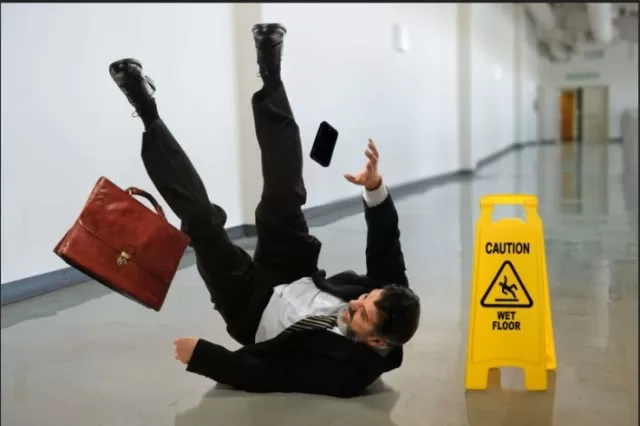Frequent Home Injury Sources: Safety Awareness Needed. Amid the comfort of our homes, a hidden realm of potential dangers lurks, ready to disrupt our sense of security at any moment.
Accidents, with their unpredictable nature, can manifest within the confines of our own dwellings, whether behind closed doors, in the confines of the garage, amidst the tranquility of the backyard, or even near the allure of the pool. Empowered by the latest insights from the Centers for Disease Control and Prevention, we’ve meticulously crafted a compilation of paramount risks and their underlying causes. This compilation serves as a clarion call, urging us to survey our living spaces with fresh eyes and proactively obliterate lurking threats. By taking measured precautions today, we defy the chilling grip of statistics, ensuring that we remain the guardians of our own safety and well-being.
Within the embrace of our abodes, let us not be lulled into complacency, but instead become champions of prevention. The amalgamation of recent data unfurls a narrative of caution, revealing the unexpected sources of peril that can unravel the fabric of our daily lives. From unseen indoor hazards to the deceptive allure of the garage, from the tranquil backdrop of the backyard to the beckoning embrace of the pool, the dangers are as diverse as they are unexpected.
Stumbling and Tumbling: A Comprehensive Exploration of Accidental Falls

Accidental falls, often characterized as stumbling and tumbling incidents, stand as the predominant cause of nonfatal injuries spanning virtually all age demographics within the United States.
Recent statistics from the National Institute on Aging emphasize that an alarming 6 out of 10 of these falls transpire within the confines of one’s own home. In response to this pressing concern, the Centers for Disease Control and Prevention (CDC) introduced the STEADI (Stopping Elderly Accidents, Deaths & Injuries) initiative, primarily designed to safeguard senior citizens against the perils of trips and falls.
Interestingly, while initially targeting the elderly, the program’s recommendations resonate universally and hold merit for individuals of all generations.
The significance of this initiative becomes evident when delving into its practical advice.
Ensuring the presence and diligent utilization of handrails along staircases emerges as a fundamental preventive measure. Likewise, the strategic placement of night lights in high-traffic zones serves as an effective strategy for reducing the risk of unexpected stumbles during the darker hours.
A Key strategy recommended by STEADI involves the elimination of clutter, which can be particularly hazardous. Equally important, securing carpets firmly to the floor curtails the likelihood of tripping over loose edges.
Meanwhile, an often overlooked aspect—ensuring electrical cords are neatly positioned against walls and away from commonly traversed paths—plays a pivotal role in fostering a safer living environment.
By addressing the overarching theme of tripping and falling incidents, this comprehensive exploration seeks to underscore the universal relevance of the STEADI initiative’s guidelines.
While birthed from the intent to protect senior citizens, these measures resonate beyond age boundaries, advocating for a safer, more secure living space for individuals of all walks of life.
Perilous Potions: Unraveling the Dangers of Poisoning in Domestic Settings
Poisoning, an alarming and often underestimated hazard, casts a shadow of concern primarily within the confines of one’s own home.
Remarkably, a staggering 90 percent of instances involving poison exposure occur within this seemingly safe haven. This issue, particularly concerning for households with children, warrants meticulous attention and proactive measures to avert potential catastrophes.
Children, in their innate curiosity and exploration, can unwittingly subject themselves to harm by ingesting common household chemicals such as bleach and various cleaning products.
The consequences of such inadvertent encounters manifest as distressing symptoms including nausea and vomiting, underscoring the urgency of safeguarding these substances. Alarmingly, the risks extend beyond ingestion, as the accidental spraying of noxious chemicals into delicate young eyes remains a grim possibility.
Beyond the realm of traditional household chemicals, an array of seemingly innocuous items also holds the potential for toxicity.
Items such as makeup, lotions, vitamins, and even certain plant species can wield harmful effects if improperly handled or consumed. Such instances accentuate the necessity for heightened vigilance and awareness, particularly when it comes to the safety of vulnerable individuals, including children.
Mitigating the threat of poisoning necessitates the implementation of comprehensive preventive strategies.
Central to this effort is the prudent practice of securely storing all cleaning products and potentially hazardous substances out of reach and sight of children. This proactive step forms a crucial barrier against accidental exposure.
Furthermore, for those who engage in tasks involving potent cleansers, adopting a defensive stance through the use of goggles and gloves serves as a formidable defense against fumes and unintended splashes.
In the realm of household safety, the specter of poisoning demands unwavering attention and diligence.
By delving into the intricacies of this issue, we shed light on the paramount significance of safeguarding against toxic encounters within the domestic sphere. Through vigilant practices and a deepened understanding of potential hazards, we aspire to cultivate a home environment where the specter of poisoning is resolutely countered, promoting the well-being and security of all occupants.
Aquatic Perils Unveiled: Unraveling the Menace of Water Accidents

Within the mosaic of life’s risks, water accidents stand as an alarming and somber reality, demanding our collective attention.
Drowning, a haunting and pervasive specter, solidifies its place among the top five causes of mortality spanning all age groups within the United States. Beyond the realm of fatality, the survivors of such harrowing ordeals teeter on the precipice of enduring brain damage, a poignant reminder of the enduring repercussions that water-related mishaps can entail.
A key facet in the battle against water accidents is the imperative to foster water competency and safety awareness, starting with the youngest members of our communities.
By instilling the invaluable skill of swimming in children and acquainting them with the intricacies of water safety, we establish a foundation upon which future encounters with aquatic environments are built. Simultaneously, as guardians of aquatic realms, it becomes our responsibility to ascertain the swimming prowess of our children’s peers and other visitors, enabling informed decisions when it comes to supervision.
While the presence of water offers boundless opportunities for recreation and leisure, it inherently demands a respectful approach and proactive safeguarding.
During moments of aquatic revelry, the indispensable presence of a vigilant and CPR-trained adult becomes an integral shield against potential mishaps. The strategic accessibility of floatation devices serves as a tactile reassurance, ready to swiftly avert emergencies as they arise.
Yet, amid these prudent preparations and precautions, an unwavering sense of vigilance remains paramount.
The enduring refrain echoes: Be vigilant. This encapsulates the essence of our commitment to the safety and well-being of those within aquatic realms.
In its simplicity, this call to attentiveness underlines the profound importance of unwavering focus and dedicated guardianship, as we navigate the multifaceted waterscape of potential risks.
The specter of water accidents compels us to delve into the depths of understanding and preparedness.
By acknowledging the dire implications of drowning and its aftermath, we awaken to the urgency of our role as stewards of safety. Through education, supervision, and unyielding vigilance, we endeavor to rewrite the narrative surrounding water accidents, steering towards a future where the shimmering allure of water is coupled with an unshakable commitment to safeguarding every precious life it touches.
Tumbling Hazards: Navigating the Peril of Falling Objects
In the intricate tapestry of potential dangers that surround us, falling objects emerge as a silent yet formidable adversary, particularly targeting the vulnerability of children and adolescents.
Among them, the younger members of our society, toddlers in particular, stand as unwitting protagonists in scenarios where seemingly innocuous items become hazardous projectiles. Books, substantial decor, and even petite appliances bear the potential to transform into gravity’s instruments in the hands of these curious explorers.
The risk, however, does not wane with age, evolving to encompass individuals navigating elevated spaces.
Adolescents and adults perched precariously on ladders or step stools find themselves ensnared in a paradox where their quest to reach objects aloft is juxtaposed with the impending threat of being struck by their very targets. This poignant reminder underscores the intricate balance we must strike when pursuing accessibility amidst the heights.
Cognizant of the multi-faceted challenge posed by falling objects, a proactive approach to prevention takes center stage.
Crafting a protective perimeter around our youngest charges, we endeavor to position weighty decor and household apparatuses well beyond their grasp. In this simple yet vital step, we erect a barrier between their insatiable curiosity and the potentially perilous contents within their surroundings.
Simultaneously, as we navigate the landscape of grown-up aspirations, humility finds a place in the call for assistance.
When confronted with the task of accessing substantial objects suspended overhead, a humble request for aid transforms into an embodiment of wisdom and self-preservation. The poignant reminder reverberates: Seek help when needed.
The realm of falling objects, with its potential for harm, calls upon us to weave a narrative of precaution and proactive measures.
By acknowledging the differential risks faced by various age groups and embracing a symbiotic relationship of mutual support, we set the stage for a safer, more secure environment. In doing so, we strive to dismantle the lurking threat of falling objects, ensuring that each moment spent within our spaces is graced with a heightened sense of awareness and safeguarding.
Balancing Act: Navigating the Perils of Overexertion

Embarking on an ambitious agenda, whether it involves taming the wilds of your yard or delving into creative projects, carries with it the twin companions of potential achievement and an often underestimated risk – overexertion.
A silent protagonist in the realm of accidents, overexertion stealthily claims its position as a top contributor to home and workplace mishaps, casting its shadow over countless daily activities. In its wake, a concerning cascade of emergency room visits beckons attention, underscoring the need for proactive measures and a heightened awareness of our body’s limits.
The allure of engaging tasks, even those laden with enjoyment, can mask the gradual toll they exact on our physical well-being.
Whether we find ourselves immersed in the art of home renovation, fashioning creations from wood, meticulously cleaning, or even indulging in the world of video gaming, the line between productive engagement and overextension can blur if left unchecked.
The art of safeguarding against overexertion, then, assumes a paramount role in the realm of well-being.
A cornerstone of this endeavor lies in the cultivation of a mindful approach, wherein we attune ourselves to our body’s cues and limits. By fostering an acute awareness of when fatigue sets in and energy dwindles, we lay the foundation for a balanced and sustainable approach to our endeavors.
Yet, the reach of this endeavor stretches beyond personal awareness, embracing the realm of intergenerational education.
In imparting the wisdom of knowing one’s limits, we equip our children with a critical life skill that extends far beyond the immediate context. Through dialogue and demonstration, we sculpt a framework of self-preservation, fostering a generation capable of charting their courses with prudence and caution.
Ultimately, the narrative of overexertion encapsulates a symphony of caution, awareness, and adaptation.
As we navigate the intricate rhythms of daily life, the need to harmonize our ambitions with our body’s capabilities becomes undeniable. Through conscious hydration, mindful pacing, and the wisdom of knowing when to pause, we unravel the intricate dance of overexertion, ensuring that our pursuits culminate in triumph rather than the silent toll of preventable mishaps.
*The information is for reference only.